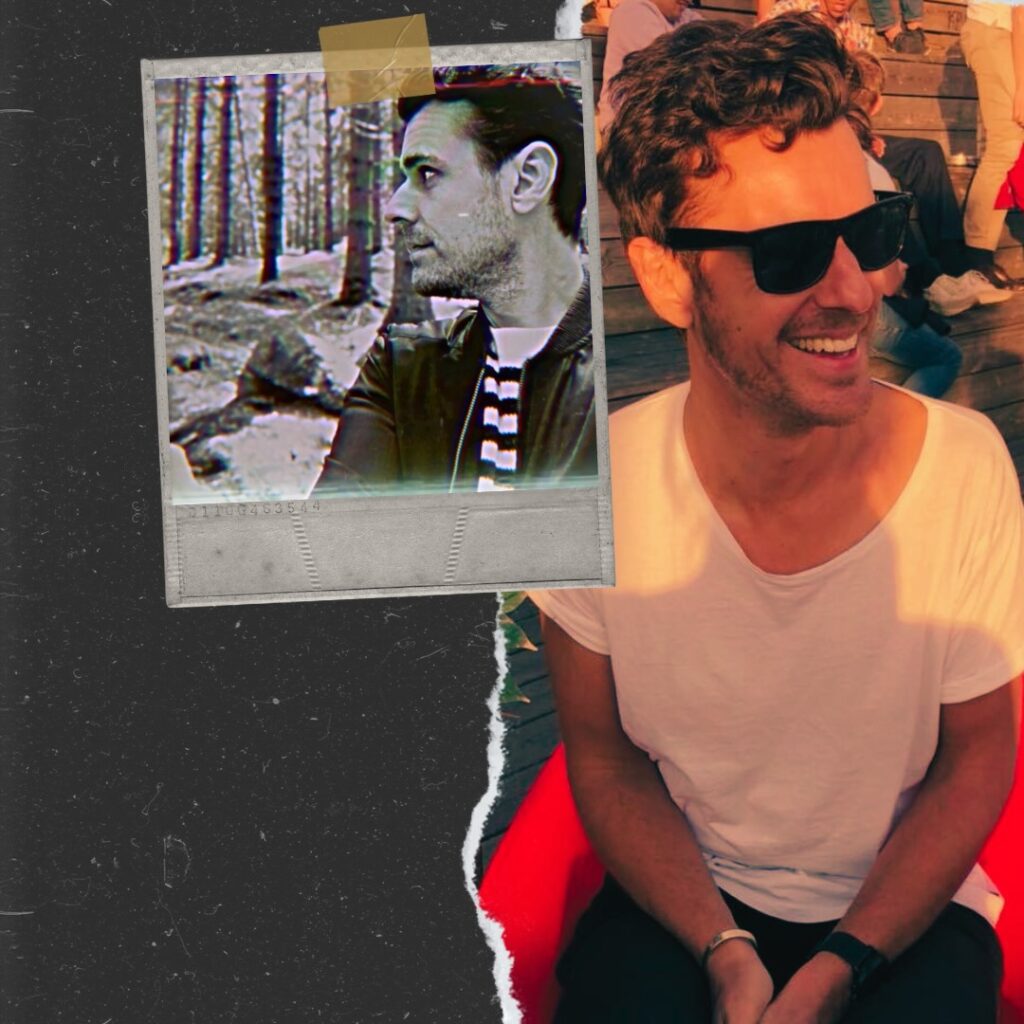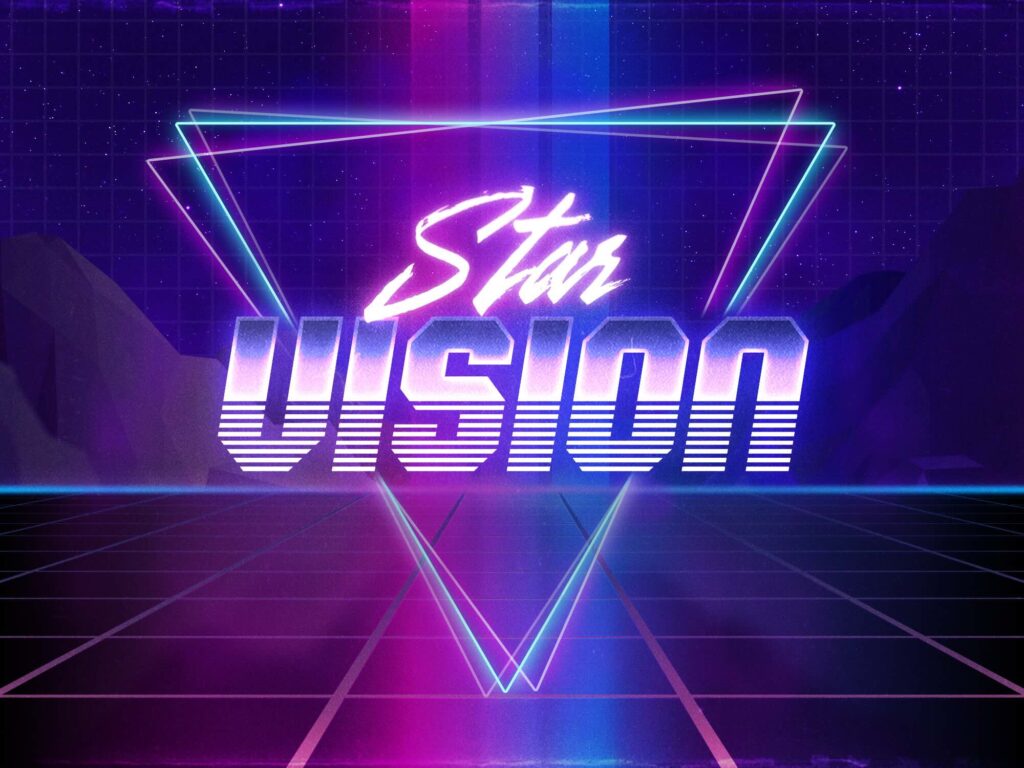80s enthusiasts are likely to rejoice when hearing Star Vision’s latest offering. A stunning, eclectic rendition of Lionel Richie’s ‘Running with the Night’, the track showcases all of the nuanced artistry championed so proudly by Swedish musician Scott van Dort. Known by night with his moniker Star Vision, the talented creative blends classic synthwave energy with AOR, guitar-powered flair.
The result is a piece brimming with lush synths and punchy drum machines, together with elegant distortions and an authentically 80s guitar solo, here performed by Jimmy Konsta, from German progressive metal band We Are Legend. Set for release this coming Friday – March 21st – ‘Running with the Night’ is an extremely interesting effort, especially given the way it playfully uses nostalgia to innovate and refresh an existing composition (there’s a preview of the single further down…).
You can pre-save ‘Running with the Night’ here.
Intrigued by the project, we caught up with Scott van Dort aka Star Vision to learn more about his artistry and future goals… Interview below!
Hey Scott (aka STAR VISION), how is it going? You and I share an obsession for the 80s. Why do you feel so nostalgic towards that era, and why do you think so many people relate to vintage tones nowadays?
I’m doing great, thanks! Great question – I think there are really three reasons why I am so nostalgic about the era. First, it’s the one I grew up in—so all my childhood memories are tied to it—TV shows, video games, first concerts, first albums, first movies. Thinking about that time brings me back to when life was simpler, when my whole family was still around, before losing loved ones, the innocence of youth and long before social media and smartphones became a way of life.
Music-wise, the 80s and 90s had so much emotion. Back then, artists really sang—they put their heart into it. The music and melodies have survived and I think that’s why so many newer artists are covering songs from that era. Creating music for Star Vision takes me back to a time before I cared about what was “cool” or what fit into a genre—back when I was just a kid, listening to whatever was on the radio. That’s the heart of Star Vision—tapping into what was there before “all the noise” of life and outside influences crept in.
As for the “vintage tones,” I think some people probably see them as kitschy, but then something deeply nostalgic and emotional about those melodies and arpeggios, especially when paired with era-specific synths or guitar tones. I think that’s why synthwave is so popular or why an artist like Sunglasses Kid resonates so much—he’s not just recreating the sounds but also the emotion and feeling that come with them.

Your current work is the result of a long journey; What first drew you to making music?
I must have been 11 or 12 years old when I saw Guns n’ Roses and I thought to myself, “I want to do that”. I think that’s probably the same for any kid who makes the decision to make music. Bass guitar was my first instrument and I played in a few bands with friends but quickly realized someone had to write the songs if we were ever going to do anything. So, I bought up a Tascam 4-track cassette recorder and started experimenting—writing songs, playing with machines, and playing around with synths. Looking back, I’ve always felt most at home creating music and shaping productions to express myself, more than being in a band.
‘Running with the Night’ is your latest effort set to release this Friday, a rendition of a Lionel Richie staple. What made you pick this record, and how did you go about interpreting it in a personal way?
My family had Lionel Richie’s Can’t Slow Down on cassette, and we played it all the time. Late last year, I listened to the album for the first time in decades, and when Running with the Night came on, it just hit me. Unlike his other R&B-leaning hits, this one had a rock edge, and I immediately imagined it with bigger guitars and synths. That became my approach—honouring the original while bringing out the rock elements even further by dialling up the guitars and synths. After releasing a couple of EPs and a single last year, I thought it’d be fun to put out a cover—both to introduce new listeners to Star Vision, showcase broader influences, and keep exploring and refining my own sound.

From a production standpoint, what’s your usual setup? Do you work in the box or with analogue synths? Are there any tips and tricks for an authentically vintage sound that you can share with our audience?
My setup is actually really basic but also distinct. First, for guitar tones, chorus and reverb are essential for those signature clean, shimmering sounds of the 80s. I use a Fender Strat and a Roland Jazz Chorus amp, which, to me, is the sound of the 80s. As soon as I play a simple arpeggio or ring out a chord through that Jazz Chorus, I’m transported back to that era. For drums, I use an old Alesis SR-16 drum machine.
The challenge is, compared to plug-ins that sync perfectly with a DAW, the drum machine is really time-consuming. it requires extra cables, MIDI interfaces, and a lot of tweaking—but the sound is worth it. I’m a big believer in creative restriction. With endless sound libraries, plug-ins, and effects at our fingertips, it’s easy to get lost tweaking and sourcing sounds instead of creating. while I don’t own any vintage analogue synths, I’m very intentional about the sounds I choose.
Synths and pads are a huge part of my sound, but I like to keep it really simple. In fact, I rely on just two plug-ins for all my keyboard sounds and then everything runs through a Valhalla plate reverb.
The AOR-esque guitar is a perfect match for ‘Running With The Night’, props to you for adding it. Was that Jimmy Konsta’s idea or did you direct the part?
Thanks so much! Jimmy is an incredible guitarist, and he’s played lead on both Star Vision EPs. Honestly, he’s one of my favorite guitarists—I am lucky I found him and it’s such an honor to have him on my records. Few players combine emotion, technique, and melody the way he does. When I reached out for this song, I gave him clear direction on what I was looking for and where I wanted the guitars to sit. But Jimmy was adamant about not just copying what Steve Lukather did—he wanted to make it his own. By now, he knows my sound, and what he delivered went beyond my expectations.
For example, in the second chorus, there’s this lead line that weaves around the vocals—that was all him. Same with the guitars in the second verse and everything he adds during the breakdown. So, yeah, I gave him guidelines about where I wanted the guitars but, again, he knows the type of guitar sound and playing I am looking for, so in the end, he played through the whole track, and in doing so, he shaped the sound in a big way.
The video version on YT opens with a short frame of the classic DVD logo. Hear me out: as time passes, all the different decades morph into a single ‘retro’ cultural blur (for instance 80s and 90s are now not that well separated in popular culture). Do you agree?
While I know what you’re saying, I disagree! Ha, ha! For me, they are two very different decades. Whether it was music, film or fashion, I think the 80s was a lot more experimental and “out there” than the 90s. Production alone, I can tell an album that was produced in 1989 versus 1991. Drums and synths sound very different between those two decades, especially in pop and rock music. I think the music scenes and movements between the 80s and 90s were very different too. For example, grunge is distinctively 90s, while synth pop and new wave are distinctively 80s. Similarly, rock and heavy metal sounded very different in the 80s than it did just a decade later.
Artistically speaking, what challenges have the last two years presented you with?
I think every artist today finds it challenging to get their music heard simply because of the overwhelming amount of new releases dropping daily. I think that’s why knowing your audience and your niche is really important and focusing on that rather than trying to simply reach as many people as possible. In general, I would say it’s not always easy to find the right live opportunities for this type of music. I am really happy with all the shows I’ve done but getting chosen for showcases or finding venues for this type of music and with my solo set-up (as opposed to a band) is challenging. But again, there are venues and it’s about finding out where you fit in and creating the right opportunities.
What are the next steps for your project? Anything exciting on the horizon?
I’m excited to share that I have the next four releases already lined up. After this single, I’ll be dropping a remix of a previous track, followed by two brand-new songs that I’m absolutely thrilled about. With those two new tracks, I feel like I’ve really nailed the sound of Star Vision, getting really specific about what my sound is and hopefully creating something unique. This summer, I’ll be performing a couple of shows in Sweden to coincide with the release of the singles. Late last year and early this year, I had been writing and co-writing songs for a well-established AOR band here in Sweden. I pitched a few ideas and we’ll see if anything comes from that and if we can work together. Aside from that, I’ll also keep having fun recording vocal covers on YouTube, which is something I really enjoy doing.



